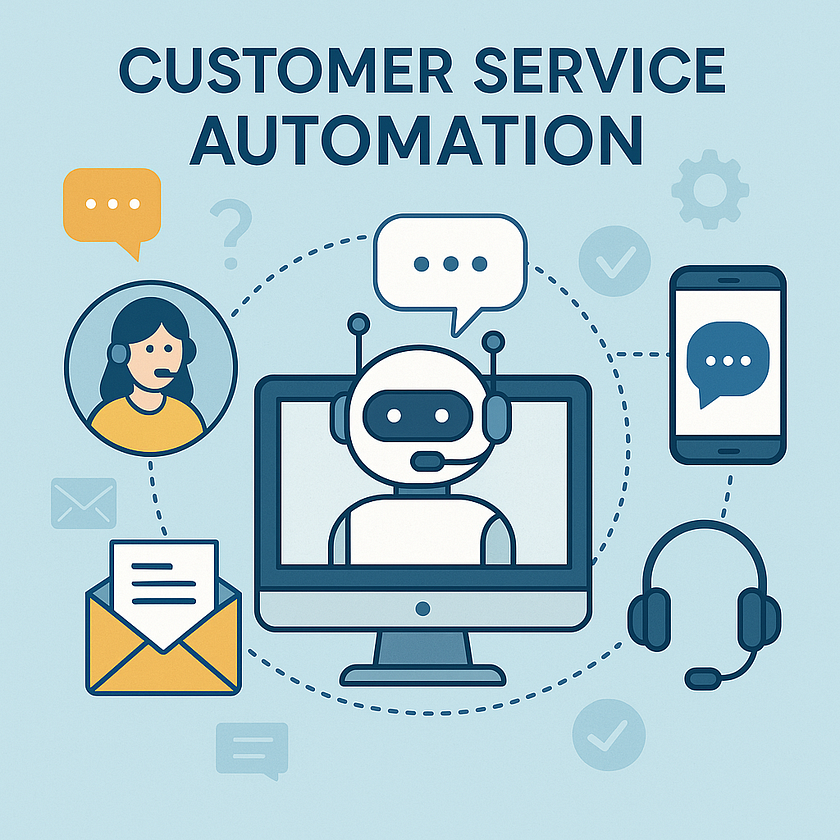Customer Service Automation: Transforming Customer Experience in the Digital Age

In today’s fast-paced digital environment, customer expectations have evolved dramatically. People want quick responses, 24/7 availability, and personalized experiences. To meet these growing demands, businesses across industries are turning to customer service automation. This transformation not only enhances customer satisfaction but also reduces operational costs and improves overall efficiency. Let’s explore what customer service automation is, how it works, its benefits, and potential challenges.
What is Customer Service Automation?
Customer service automation refers to the use of technology — like AI-powered chatbots, automated emails, and self-service portals — to handle customer support tasks without human intervention. These systems are designed to manage routine queries, offer instant responses, and streamline communication across channels such as websites, social media, messaging apps, and more.
Instead of waiting in long call queues or waiting for a human agent to respond to emails, customers can instantly get answers to common questions or be directed to the right support channel with minimal effort.
Key Technologies Driving Automation
1. AI-Powered Chatbots
AI chatbots are among the most popular tools in customer service automation. They use natural language processing (NLP) to understand customer queries and provide intelligent, human-like responses. Some advanced bots even learn from customer interactions and improve over time.
2. Interactive Voice Response (IVR) Systems
IVR systems are automated phone systems that guide customers through menus to find answers or connect with the appropriate department. These have become more advanced with the integration of voice recognition technology.
3. Automated Email Responses
Businesses often use automated email workflows to respond to common queries, confirm order details, provide updates, and follow up on service requests.
4. Self-Service Portals
These portals include FAQs, knowledge bases, and community forums where customers can find solutions independently. Well-structured self-service options can resolve up to 80% of routine issues.
Benefits of Customer Service Automation
1. 24/7 Availability
Automated systems don’t sleep. They can provide assistance at any hour of the day, ensuring customers from different time zones or those seeking help outside business hours are never left waiting.
2. Faster Response Times
One of the main frustrations customers face is delayed support. Automation reduces response time drastically by providing instant answers or routing queries efficiently.
3. Scalability
During high-demand periods, such as holidays or product launches, businesses may receive a spike in support requests. Automation allows them to scale customer service without hiring additional staff.
4. Cost Savings
By automating repetitive and simple tasks, companies can reduce the number of support agents required and redirect their resources toward handling more complex or sensitive customer issues.
5. Consistent Experience
Automated responses ensure that customers receive uniform and accurate information, which helps maintain brand credibility.
Use Cases of Customer Service Automation
- Retail & E-commerce: Chatbots can help track orders, suggest products, and process returns.
- Banking & Finance: Virtual assistants provide account details, transaction history, and fraud alerts.
- Healthcare: Appointment scheduling, prescription reminders, and FAQs are automated to reduce the burden on staff.
- Travel & Hospitality: Airlines and hotels use automation for booking, check-in, and itinerary updates.
Challenges in Customer Service Automation
1. Lack of Human Touch
While automation handles basic tasks well, it can fall short when dealing with emotional or complex issues that require empathy or deep understanding.
2. Miscommunication
AI systems, especially less advanced ones, can misinterpret queries leading to frustration and poor customer experience.
3. Implementation Costs
Setting up sophisticated automation tools can be expensive and time-consuming, especially for small businesses.
4. Security and Privacy Concerns
With automation handling sensitive data, ensuring compliance with data protection regulations is crucial.
Striking the Right Balance: Automation + Human Support
The best customer service strategies blend automation with human support. For example, a chatbot can greet users, gather information, and escalate to a human agent when needed. This hybrid approach offers the best of both worlds — speed and efficiency from automation, and empathy and problem-solving from human agents.
Future of Customer Service Automation
With advancements in artificial intelligence, machine learning, and voice technology, the future of customer service automation is incredibly promising. We can expect smarter virtual assistants that understand context better, handle more complex queries, and offer hyper-personalized support.
Moreover, integration with customer relationship management (CRM) systems will provide a 360-degree view of customer history, allowing for more effective and customized service experiences.
Conclusion
Customer service automation is no longer a luxury — it’s a necessity for businesses aiming to stay competitive and meet modern consumer expectations. When implemented thoughtfully, automation can greatly improve efficiency, satisfaction, and scalability, all while reducing costs.
However, it’s important to remember that automation is a tool, not a complete replacement for human interaction. Companies that balance tech-driven efficiency with human empathy will be the ones who truly win in the customer service game.



Comments
Post a Comment